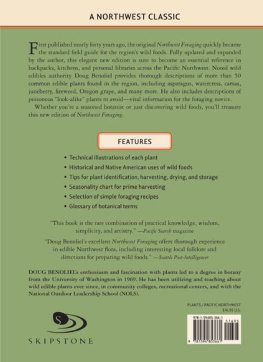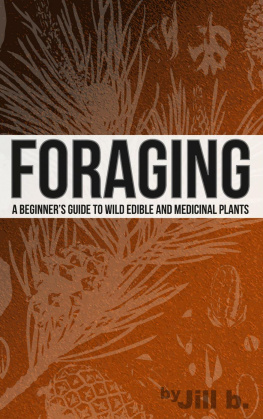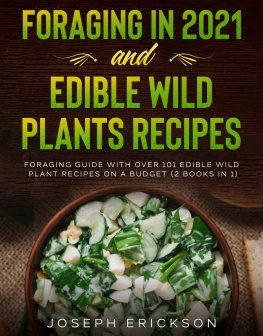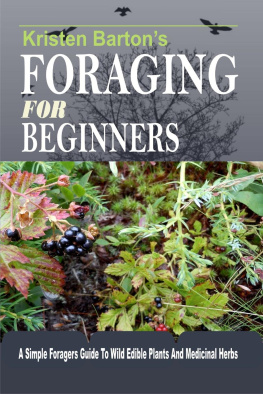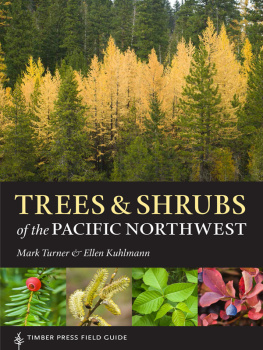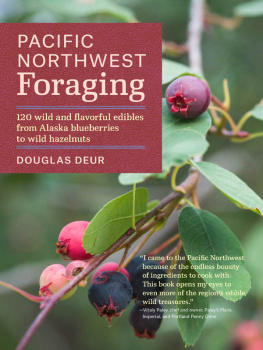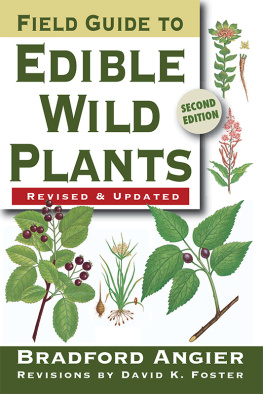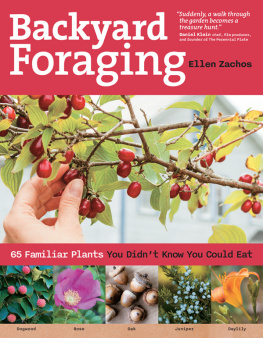
NORTHWEST
FORAGING
2011 by Doug Benoliel
All rights reserved. No part of this book may be reproduced or utilized in any form, or by any electronic, mechanical, or other means, without the prior written permission of the publisher.
Published by Skipstone, an imprint of The Mountaineers Books
Printed in the United States of America
First printing 2011.
14 13 12 11 5 4 3 2 1
Copy Editor: Barry Foy
Design: Jane Jeszeck/Jigsaw, www.jigsawseattle.com
Cover artwork: Mark Orsen
All illustrations by Mark Orsen
ISBN (paperback): 978-1-59485-366-1
ISBN (e-book): 978-1-59485-367-8
Library of Congress Cataloging-in-Publication Data
Benoliel, Doug.
Northwest foraging: the classic guide to edible plants of the pacific
Northwest / by Doug Benoliel; illustrations by Mark Orsen.
p. cm.
Originally published: Lynnwood, Wash.: Signpost, 1974.
Includes bibliographical references and index.
ISBN 978-1-59485-366-1
1. Plants, EdibleNorthwest, PacificIdentification. 2. Poisonous plantsNorthwest, PacificIdentification. 3. Cooking (Wild foods) I. Title.
QK98.5.U6B46 2011
581.6'32dc22
2010043716
Skipstone books may be purchased for corporate, educational, or other promotional sales. For special discounts and information, contact our Sales Department at 800-553-4453 or .
Skipstone
1001 SW Klickitat Way
Suite 201
Seattle, Washington 98134
206.223.6303
www.skipstonebooks.org
www.mountaineersbooks.org
This book is not intended as a substitute for professional advice or your own good judgment. Foraging for any foods requires significant care and knowledge. Prevailing rules and regulations should be adhered to in any beach, park, city, county, state, or federal lands that you visit.
The publisher and author are not responsible for any adverse consequences resulting directly or indirectly from information contained in this book.
LIVE LIFE. MAKE RIPPLES.
To the great outdoors
and all of those who cherish it
and take care of it

CONTENTS
FOREWORD TO THE ORIGINAL EDITION
Popular interest in natural foods and medicinal and kitchen herbs has had a great surge in recent years. Unfortunately, some books and frequent statements in advertising and the press are either misleading or dishonest. Folk science is often more interesting than true. Since science seems rigid and cold, we often find greater comfort in the familiar, the homeyand at times in magic.
In this volume, Doug Benoliel has selected from an enormous amount of popular literature. He presents a careful guide to locally significant nature plants. He warns against the major dangers (or common human frailties) and suggests only foods that he has used and can recommend. His methods have been tested by students in his classes.
There are a large number of teas that have special interest to me. Some of the claims of the curative power of tea are highly exaggerated in some of our literature. To me, the most important value of tea (any kind) is the chance to sit down, wait for the tea to cool enough to drink, and to chat with friends. It isnt medicine or magicits calmness in a busy world.
Seeing plants in the field, whether you collect them or not, and making a start in your own plant exploration can be rewarding. This manual can help in many ways.
H. Weston Blaser
June 1974
(H. Weston Blaser, 19101976, was a professor in the Department of Botany at the University of Washington.)
PREFACE
I have always been a plant enthusiast. I cant remember a time when I wasnt intrigued by flora and their environment, whether it was planting Douglas-fir seedlings for an international timber company, planning and growing my own large vegetable garden with my wife, teaching National Outdoor Leadership School (NOLS) students about edible wild plants in the Wind River Range of Wyoming, or studying the alpine and subalpine plant ecology of Washingtons Olympic Mountains.
As a landscape designer/contractor with my own company, Native Landscaping & Design, I have designed and built dozens of residential gardens in the Puget Sound area. For thirty years my wife and I operated our own wholesale plant nursery, The Sweetbriar, and we recently ventured into the business of organic vegetable and fruit farming on Lopez Island, in the San Juan Islands of Washington State.
My fascination with edible wild plants resulted from the intersection of an interest in native plants, a love of good and flavorful food, and a willingness to eat unusual things. Working at the National Outdoor Leadership School in the early 1970s gave me the opportunity to eat foraged plants in the course of multiple five-week-long backpacking trips. This in turn led to teaching foraging classes at various community colleges and recreation centers in the greater Seattle area through much of the 1970s. Northwest Foraging represents the accumulated information that I gathered, developed, and organized for those classes.
Foraging is relevant for those of us who love and appreciate the wonders of eating fresh, organic fruits and vegetables from the garden. After all, the underlying principle is the same: Its simply a joy to eat well-grown food from healthy soil. And the joy is enhanced if the food comes as a result of ones own labor, whether that labor consists of digging and weeding in a garden or seeking out and harvesting plants in the wild.
People are more concerned than ever about the quality of the food that they put into their bodies. The growth in recent years of the whole-food and organic food movements, as well as of community-supported agriculture, is evidence of that increased awareness. As it happens, wild edibles are an excellent source of good food. Foraging is an easy way to supplement and add diversity to ones diet, and at minimal expense.
But foragings benefits dont stop at the merely practical: What better excuse could you have to enjoy an excursion into the wilds, either alone or with companions? Go foraging!
Doug Benoliel
Lopez Island, Washington
October 2010
ACKNOWLEDGMENTS
My curiosity and excitement about plants began when, at the age of six or seven, I successfully transplanted a lettuce plant that I had been told wouldnt grow. To both my father and mother I express appreciation for letting me play and work in the vegetable and flower gardens. That would lay the groundwork for many sunny hours spent and much summer money earned working with plants in subsequent years.
My formal education began at the University of Washington in 1965, where I enjoyed the teaching of many good botany instructors, including Clarence Muhlick, Dr. C. Leo Hitchcock, Dr. Daniel Stuntz, and Dr. Weston Blaser. Dr. Blaser in particular was of much direct assistance in the preparation of this books original manuscript, providing many valuable suggestions and corrections. My thanks to all these teachers.
Following graduation, I had the opportunity to learn and teach at the National Outdoor Leadership School in Lander, Wyoming, for three summers. This provided a wealth of firsthand experience in living with and eating mountain plants, and my memories of the place and the people will be with me for a longtime.
Next page
